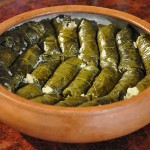
“My respect towards pasuts tolma increased at the moment I ate what my grandma had made. And now every time I try to cook it like her, something is still missing. I do not feel the smell and aroma of her pasuts tolma, even though my children like it the way I make it,” says 37-year-old Sveta and starts the special ceremony of pasuts tolma cooking.
Pasuts tolma is an Armenian traditional dish made of red or black bean, lentil, pea, green pea, bulgur, and rice, rolled up in cabbage or grape leaves.
The word ‘pasuts’ in Armenian is connected with the word ‘pahk’ or ‘pas’ (fasting). Pasuts tolma stuffing does not contain any ingredients prohibited by the Armenian Easter fast. (During 48 days of Lent, observers of the fast should stick to a vegen diet – no eggs, meat, fish, etc.)
Sveta cooked all the necessary ingredients to be used in pasuts tolma the previous evening. The previously cooked 0.5 kg bean, pea, green pea, 300-400 grams spelt or bulgur, and 0.5 kg lentil (washed but not cooked) are on the kitchen table. While cooking, she added some salt to each ingredient (depending on taste).
She peels 1 kg onion, cuts it into small pieces, puts it into 700 grams (vegetable) oil and puts the pan on a gas fire.
“Many like mincing the onion; however, I prefer not doing so. When mincing the onion, it loses the juice, and in case of cutting it, the juices appear while preparing the stewed onions, and the juice gives an additional good flavor to it,” Sveta says, continuing to mix the stewed onions.
When the onions become golden, she adds a tablespoon cayenne pepper, and dried savory and some dried basil. Sveta says that it is necessary to cook the basil and savory in the stewed onions for a while, because they are dried.
Though part of a spiritual pursuit, the aroma of pasuts tolma is temptation toward gluttony as the smell of savory and basil fills the kitchen advertising the pleasure to come.
In ten minutes, Sveta adds four tablespoons of tomato paste to the stewed onions, and keeps on mixing.
“Pasuts tolma depends in large part on the pea and lentil, so it is important to cook them to their best taste. Most of our housewives master this secret,” she says and starts the most important procedure of pasuts tolma cooking ceremony.
Sveta adds the cooked red beans, green peas, peas, spelt and lentil to the stewed onions. At the end, she adds one cup of rice to the six ingredients.
Sveta explains that after cooking beans, green peas, lentil, and spelt, they should not be drained.
“Their whole flavor is in the water (juice) they are cooked in, so there is no need to drain them, and that water is mixed with the stewed onions,” she says, mixing the multi-colored stuffing of pasuts tolma.
At the end, she adds a tablespoon of salt; some chopped parsley and coriander (depending on taste) to the whole mass. She closes the pan with a lid and leaves the mass to be cooked in the steam.
While the mixture is steaming, she takes a big cabbage head, and picks its leaves one by one. She put 1.5 liters of water mixed with a tablespoon of salt on gas fire beforehand. When the water starts boiling, Sveta puts the cabbage leaves into the pan.
“When we feel that the leaves soften, we must take them out and put into cold water. It is necessary to keep them in hot water on briefly, so that later the leaves do not tear while cooking the tolma. Later we put the cabbage leaves into a strainer,” Sveta explains.
The stuffing of pasuts tolma is still being cooked in a slow fire. Steva removes the hard parts of the cooked cabbage leaves and prepares them for rolling.
The stuffing is ready. The next important phase starts. Pasuts tolma is rolled up in big cabbage leaves, as a result big and juicy tolmas turn out. Sveta puts three tablespoons of stuffing into one cabbage leaf (of course, depending on the size of the leaf).
Sveta rolls up the tolmas masterly and very fast. The cabbage leaves silently obey the flexible movements of her fingers.
She layers the bottom of a pot with cabbage leaves onto which she then puts the wrapped tolma row by row until the pot is filled. Sveta adds 4-5 glasses of water to it, and puts the pan on gas fire to cook it for 30 minutes.
“We usually cook pasuts tolma for the New Year table. I remember how my grandmother was cooking it and she was giving them to our neighbors, too. She used to say that we must give in order to have a rich and promising year,” Sveta recalls.
The aroma of pasuts tolma is spread in the whole house. It is almost ready, but Sveta says that pasuts tolma can be eaten only when it is cooled, but usually it is more delicious the next day, when all the flavors are mixed with each other.
“Pasuts tolma is as motley as tasty. While eating one tries to guess the tastes of greens, however, they remain a secret; a secret as the pasuts tolma cooked by my grandma is. And now every time while cooking it I try to re-find the flavor of her pasuts tolma . . .”
The following ingredients are necessary to cook pasuts tolma:
700 grams vegetable oil
1 kg onion
0.5 kg red/back bean
0.5 kg green pea
0.5 kg lentil
0.5 kg pea
300-400 grams spelt or bulgur
250 grams rice
2 tablespoons salt
1 tablespoon cayenne pepper
black pepper depending on taste
4 tablespoons of tomato paste
dried savory and basil (depending on taste)
coriander (depending on taste)
parsley (depending on taste)
one large head of cabbage
How to cook pasuts tolma:
Put 1 kg of onions (previously cut into small pieces) into 700 grams of oil, and put the pan on heat. When the stewed onions become golden, add 1 tablespoon of cayenne pepper, dried savory, and a little dried basil (depending on taste) and cook it for 5 minutes. Later add 4 tablespoons of tomato paste to the stewed onions and wait a few minutes. Then add 0.5 kg cooked red beans, 0.5 kg green peas, 0.5 kg peas, 0.5 kg lentil, 300-400 grams spelt (or bulgur) and 250 grams rice. Mix the mass properly, then add 1 tablespoon salt, chopped coriander and parsley. Mix again; close the pan with a lit, and cook for some 30 minutes in the steam.
Boil 1.5 liters of water in a separate pan, add 1 tablespoon of salt. Remove cabbage leaves carefully. Place cabbage leaves in boiling water to soften. Remove and put in cold water, then into a strainer. When cooled, remove the “spine” to make easier to roll.
When the stuffing of pasuts tolma is ready, start the main procedure: put cabbage leaf on your palm (if it is too big, you may put it on a cutting board), add one or two tablespoons of the stuffing, and roll into a cigar shape.
Put some cabbage leaves on the bottom of another pot. Arrange the rolled pasuts tolmas there row by row. After finishing the procedure of rolling the pasuts tolmas, put the pot on heat and cook for 30 minutes. Serve pasuts tolmas when cooled – and are more tasty the second day.










